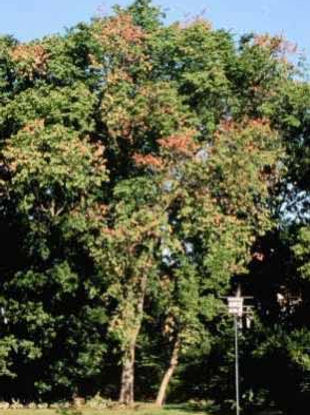
Dutch Elm Disease
How Dutch Elm Disease spreads
The American elm is the primary host of Dutch elm disease. Other elms may be infected, but in rare cases.
Dutch elm disease fungus can infect a tree in two ways. The most common method of transmission is on the bodies of elm bark beetles. The fungus also spreads from diseased to healthy trees through grafted roots.
An elm bark beetle’s life revolves around elm trees. It breeds in dead and dying elms, and depends exclusively on elm tissue for food, creating a devastating cycle for elms when the Dutch elm disease fungus (Ophiostoma novi-ulmi) is thrown into the mix. Thousands of eggs can be laid by the adult females in one piece of wood the size of a fireplace log.
If a tree dies from Dutch elm disease, every beetle that hatches and emerges as an adult from that wood may be carrying the fungus. They then will look for a healthy elm on which to feed and, once they find one, will inadvertently inoculate the tree with Dutch elm disease via the spores carried on their bodies. Research has found that the majority of new infections, and the bulk of the losses to Dutch elm disease, are due to this method of transmission. That is why prompt detection, removal, and destruction of dying elms is critically important.
The other method of disease transmission between elms is through grafted roots. When elms are growing near each other, their roots come in contact in the soil and graft together. In the absence of a vascular wilt like Dutch elm disease, this is an advantage for the trees. The Dutch elm disease fungus, however, can pass from diseased to healthy trees through these grafted roots and continue to spread indefinitely through a stand of elms.
Dutch Elm Disease Symptoms
The first evidence of Dutch elm disease is wilting or “flagging” in one or more of the branches, usually starting in the outer portion of the crown. Leaves on the infected branches turn dull green to yellow and curl, finally becoming dry, brittle, and brown. The symptoms progress down the limb and eventually throughout the entire tree. Trees infected through root grafts die very rapidly, while trees infected via the feeding of bark beetles can take several years to die. Another symptom of the disease is the discoloration of the water conducting vessels. This can be seen by peeling the bark of the infected wood, revealing the staining.
Control
Sanitation is the most effective method for controlling Dutch elm disease. This means that all dead and dying trees should be removed and the stumps ground below the surface. We can inject healthy elms with Arbortect as a preventative measure.
For more information on Dutch elm disease, read the UW Extension’s publication on the disease.





